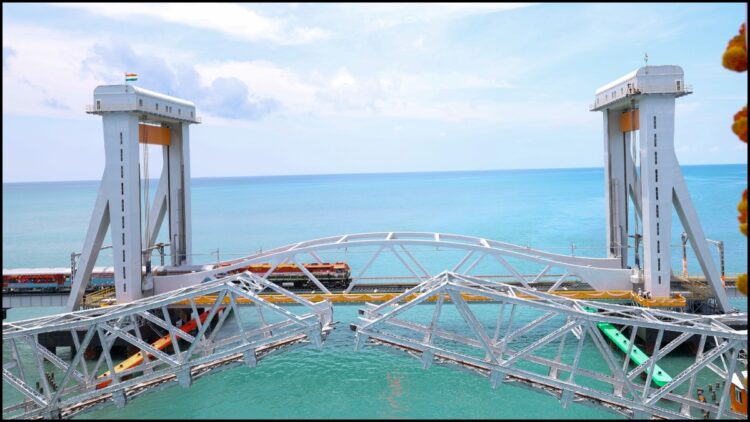Pamban Braji
Prime Minister Narendra Modi inaugurated the new Pamban Bridge in Rameswaram, Tamil Nadu on Sunday (6 April). This bridge has been in discussion for a long time due to its technology and lift spanner. The bridge connecting Pamban Island to the mainland of Tamil Nadu was destroyed in a storm in 1964. In the year 2019, PM Modi laid the foundation of a new and modern bridge in place of the old bridge and inaugurated it after six years.
A senior official said that the new bridge can easily withstand a powerful storm or more dangerous storm like 1964. MP Singh, Director (Operations) of Rail Development Corporation Limited (RVNL) said that the previous bridge was destroyed in a storm of 160 km per hour, while this time the bridge could withstand up to 230 km per hour.
What did the railway officer say?
The railway official said, “This bridge is designed to withstand the wind speed of 230 km per hour as well as a lot of earthquake. The cyclone speed of 1964 was about 160 km per hour and this caused a lot of damage to the old bridge. However, Sherger Spain, which was opened for the movement of ships, survived the chakravat and did not harm it. Can’t reach. “
Rail Development Corporation Limited has built such a bridge for the first time in India, in which the train passes in general, but the bridge is completely opened when the ship arrives and the ships can also pass easily. The railway official said that due to this, he had a lot of trouble in designing, because 61 years ago the bridge was destroyed in the storm and this time it was very important to take care of strength.
Spanner will be up only when the ship passes
The railway official said that there are some security protocols. For example, the lift spanner will be in a sitting position at all times and will be raised only at the movement of ships. Singh said that the girder placed on concrete pillars is 4.8 meters high than the sea level, so even in the event of high tide, the possibility of water level reaching the girder is extremely low. He said, “The girder of the old bridge was 2.1 meters higher than the sea level, so the water during high tide used to jump not only on the girders but also sometimes on the track.”
What happened in 1964?
On 22 December 1964, the horrific cyclonic storm in Rameswaram destroyed the rail network along with buildings. According to the Railway Ministry, the six-coach Pamban-Dhanushkodi passenger train left from Pamban at 11.55 pm on December 22, with 110 passengers, including a group of students and five railway employees. Pamban’s Bridge Inspector Arunachalam Kumarasamy was running the train. The signal disappeared at Dhanushkodi Outer and the train stopped for some time. The driver decided to take the risk and played a long whistle. Then a huge wave arose 20 feet above the turbulent sea and broke the train. The number of casualties in the initial reports was stated to be 115 (based on the number of tickets released in Pamban), but it was suspected that the death toll would have been around 200, as many passengers had traveled without tickets that night. “
The tragedy came out on 25 December, when the Southern Railway issued a bulletin based on the information received from the maritime superintendent of Mandapam. The ministry said that there are reports that large pieces of wooden coaches of the train have flowed on the banks of Sri Lanka. In addition to the train accident, the number of people who died on the island was more than 500. The ministry had said, “All communications were interrupted. Pamban bridge was swept away, only pillars, some PSC girders and lifting spans were left.”
Latest india news



